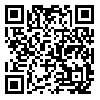Volume 2, Issue 4 (11-2020)
sjis 2020, 2(4): 10-14 |
Back to browse issues page
Download citation:
BibTeX | RIS | EndNote | Medlars | ProCite | Reference Manager | RefWorks
Send citation to:



BibTeX | RIS | EndNote | Medlars | ProCite | Reference Manager | RefWorks
Send citation to:
Yargholi M. System Level Simulation of Energy-Detection Based UWB Receivers. sjis 2020; 2 (4) :10-14
URL: http://sjis.srpub.org/article-5-83-en.html
URL: http://sjis.srpub.org/article-5-83-en.html
Department of Computer and Electrical Engineering, University of Zanjan, Zanjan, Iran
Abstract: (2827 Views)
The performance of a non-coherent UWB receiver with Binary pulse position modulation is simulated with MATLAB; taking into account the effect of non-linearity, noise, pulse shape and channel effects. This simulation examines the minimum requirements for LNA, AGC, squarer, and operational transconductance amplifier in analog front-end for sensor network application with 100Kb/s data rate and 10-3 BER. The linearity requirement in OTA is achieved using Gilbert cell OTA with the technique of multiple gated transistors. For sensor network applications, analog front-end modules must have 4dB NF (Noise figure), -12dBm IIP3, 50dB gain and -75dBm sensitivity for 100Kb/s data rates. The transceiver power consumption is assumed to be below 50mW. The performance of energy detection non-coherent receiver is simulated in Simulink of MATLAB, it shows that BER of Gaussian pulse is lower than doublet and 4th Gaussian pulse. By increasing the number of transmitted pulse per bit and IIP3, the performance of receiver is improved.
Type of Study: Research |
Subject:
Signal Processing
Received: 2020/09/10 | Revised: 2020/10/25 | Accepted: 2020/10/30 | Published: 2020/11/30
Received: 2020/09/10 | Revised: 2020/10/25 | Accepted: 2020/10/30 | Published: 2020/11/30
References
1. Yargholi M, Nabavi A. Analog front end modules design in non-coherent UWB receivers for sensor networks. IEEE Conference on Semiconductor Electronic (ICSE2008), 2008; 22-23. [DOI:10.1109/SMELEC.2008.4770278]
2. Donlan BM. Ultra-wideband narrowband interference cancellation and channel modeling for communications. M.Sc Thesis, Virginia State University, Jan. 2005.
3. Foerster JR. The performance of a direct-sequence spread spectrum ultra-wideband system in the presence of multipath, narrowband, interference, and multiuser interference. IEEE Conference on Ultra Wideband Systems and Technologies, May 2002.
4. Nekoogar M. Introduction to ultra-wideband communications. Ultra-Wideband Communications, Fundamentals and Applications, Nekoogar. Book, Chapter 1, Aug, 2005.
5. Casu MR, Crepaldi M, Graziano M. A VHDL-AMS simulation environment for an UWB impulse radio transceiver. IEEE Transactions on Circuits and Systems, 2008; 55: 1368-1381. [DOI:10.1109/TCSI.2008.916402]
6. Crepaldi M. Analysis, design and simulation of an UWB receiver for indoor localization. P.h.D Thesis, Politecnico di Torino, Italy, Nov 2005.
7. 7 Vitavasiri S. A non-coherent ultra_wideband receiver: Algorithms and digital implementation. M.Sc Thesis, Massachusetts Institute of Technology, U.S.A, May 2007.
8. Stoica L. Non-coherent energy detection transceivers for ultra wideband impulse radio systems. P.h.D Thesis, University of Oulu, Finland, Feb 2008.
9. Bo-Ting Wang S. Design of ultra-wideband RF front-end. P.h.D Thesis, California, Berkeley, USA, Fall 2005.
10. Yargholi M, Nabavi A. A highly linear Gilbert cell OTA with multiple gated transistors for non-coherent UWB receivers. IEICE Electronic Express, Integrated Circuit, 2009; 11(6): 756-762. [DOI:10.1587/elex.6.756]
11. Parvizi M, Nabavi A. Highly linear common-gate mixer employing intrinsic second and third order distortion cancellation. IEICE Electronic Express, Integrated Circuit, 2009; 6(6): 310-316. [DOI:10.1587/elex.6.310]
12. Crepaldi M, Casu MR, Graziano M. Energy detection UWB receiver design using a multi-resolution VHDL-AMS description. IEEE, Signal Processing Systems Design and Implementation, 2005; 13-18.
13. Stoica L, Tiuraniemi S, Oppermann I, Repo H. An ultra wideband low complexity circuit transceiver architecture for sensor networks. IEEE, Confrence, 2005; 364-367.
14. Revision of part 15 of the commission's rules regarding ultra-wideband transmission systems. First note and Order, Federal Communications Commission, ET-Docket 98-153, Adopted February 14, 2002, released April 22, 2002. Available: http://www.fcc.gov/Bureaus/Engineering Technology/Orders/2002/fcc02048.pdf
15. Sheng H. Transceiver design and system optimization for ultra-wideband communication. ph.d Thesis, Department of Electrical and Computer Engineering, NJIT, May 2005.
16. Choi JD, Stark WE. Performance of ultrawideband communications with suboptimal receivers in multipath channels. IEEE J Select Area Comm. 2002; 20: 1754-1766. [DOI:10.1109/JSAC.2002.805623]
17. Idriss A, Schmidt A, Zeisberg S, Finger A. Performance of a non-coherent receiver for UWB communication and ranging applications. IEEE Info Comm Technol. 2006; 2314-2319.
18. 18 Carvajal RG, Ramirez-Angulo J, Lopez-Martin AJ, Torralba A, Galan JAG, Carlosena A, Chavero FM. The flipped voltage follower: A useful cell for low-voltage low-power circuit design. Circuits and Systems I: Regular Papers, IEEE Transact. 2005; 7(52): 1276-1291. [DOI:10.1109/TCSI.2005.851387]
19. Ghabrial W. Transconductance-C filter design for wireless telecommunications receivers. P.h.D Thesis, Electrical and Computer Engineering, Carnegie Mellon University, 2003.
20. Yargholi M. A highly linear squarer design for energy-detection RF receivers. Microelect J. 2013; 44: 658-662. [DOI:10.1016/j.mejo.2013.05.003]
21. Mohieldin AN, Sánchez-Sinencio E, Silva-Martínez J. A low-voltage fully balanced OTA with common mode feedforward and inherent common mode feedback detector. ESSCIRC, Texas A&M University, USA, 2002; 191-194.
| Rights and permissions | |
 |
This work is licensed under a Creative Commons Attribution-NonCommercial 4.0 International License. |










